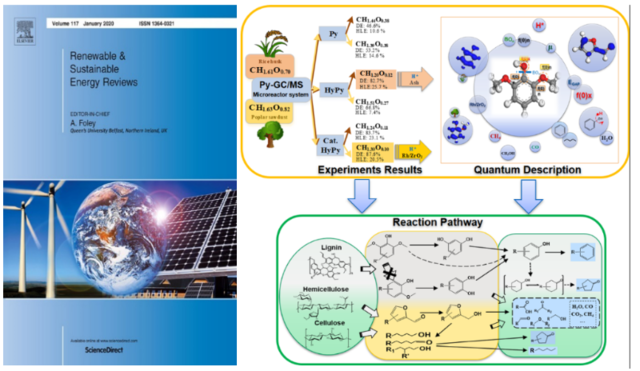On February 6, 2020, Professor Liu Ronghou's team from Biomass Engineering Research Center of SJTU, School of Agriculture and Biology published in the top-notch journal Renewable and Sustainable Energy Reviews a research paper titled "Comparative study of fast pyrolysis, hydropyrolysis and catalytic hydropyrolysis of poplar sawdust and rice husk in a modified Py-GC/MS microreactor system: Insights into product distribution, quantum description and reaction mechanism".
The first author is doctoral student He Yifeng from School of Agriculture and Biology, and the corresponding author is Liu Hourong. The co-authors also include doctoral student Chai Meiyun from School of Agriculture and Biology, Zhou Zhongyue from School of Mechanical Engineering, master student Manobendro Sarker from School of Agriculture and Biology, doctoral student Li Chong, Associate Professor Cai Junmeng from School of Agriculture and Biology, and postdoctoral student Liu Xinghua from School of Mechanical Engineering.

This research was supported by National Key Research Project and National Natural Science Foundation.
Abstract
Fast pyrolysis, hydropyrolysis and catalytic hydropyrolysis are three important methods to produce bio-oil from biomass and are of great interest to researchers. In this research, the comprehensive study of pyrolysis, hydropyrolysis and catalytic hydropyrolysis of poplar sawdust and rice husk was investigated in a modified laboratory Py-GC/MS microreactor system. Rh/ZrO2 (0.5 wt %) was prepared and applied in the catalytic hydropyrolysis process. An evaluation system including estimating method of product selectivity, the calculation method of O/C and H/C ratio, deoxygenation extent (DE) and hydrogen-loss extent (HLE), was established to fully measure the deoxygenation effect. The Rh/ZrO2-assisted catalytic hydropyrolysis showed a good deoxygenation effect as O/C ratios (0.10 for poplar sawdust, 0.11 for rice husk, respectively) are comparable to that of the reported upgraded bio-oil by hydrodeoxygenation (HDO). The highest hydrocarbon selectivity of 49.14% and DE of 87.6% were obtained in catalytic hydropyrolysis of poplar sawdust. For rice husk, the hydropyrolysis process gained a similar DE (82.7%) to that of the catalytic HyPy (83.7%), because rice husk with high ash content (19.4 wt %) contains a large number of mineral elements that are likely to form a self-catalysis effect. The reaction mechanism was further inferred according to product distribution and quantum calculation of oxygen-containing products, suggesting that Rh/ZrO2-assisted hydropyrolysis was accomplished by multistage reactions, involving initial pyrolysis of raw biomass and further deoxygenation of the pyrolysis intermediates. Moreover, this work can also provide a proven methodology and theoretical supports for future studies on catalytic hydropyrolysis of biomass.
Paper Link: https://www.sciencedirect.com/science/article/pii/S1364032119308123
Translated by Li Wenqi Reviewed by Wang Bingyu

